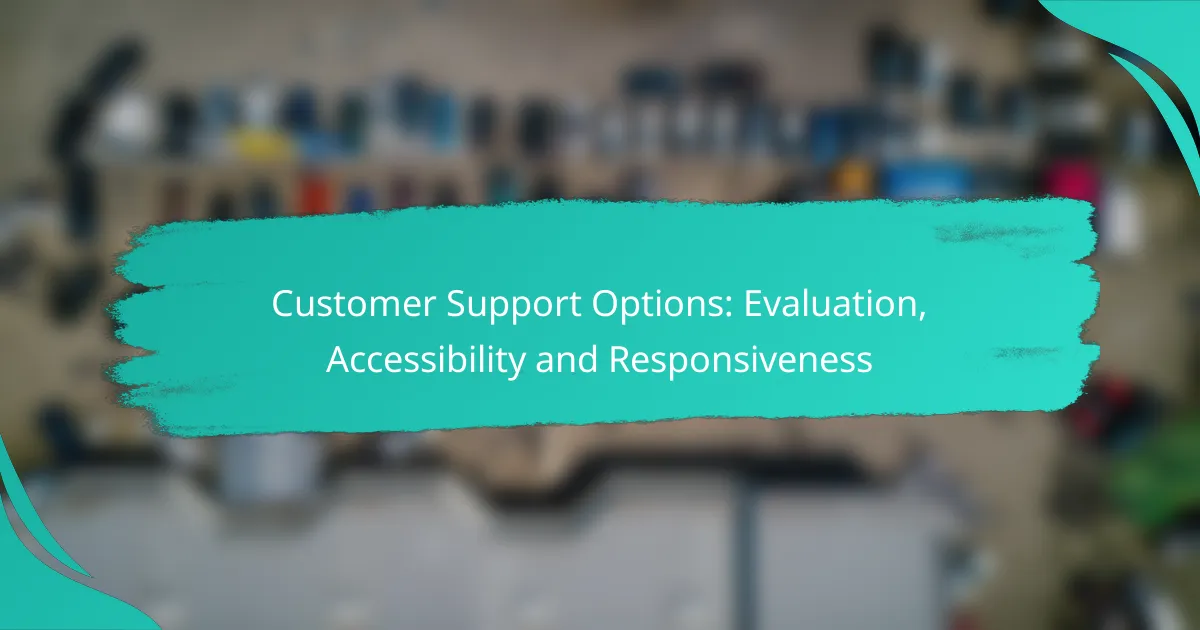In today’s digital landscape, effective customer support is essential for businesses to thrive. Evaluating options such as live chat, email, and social media helps ensure accessibility and responsiveness, catering to diverse customer needs. By focusing on response times and the effectiveness of communication channels, companies can enhance their support services and improve customer satisfaction.

What are the best customer support options for digital products in Australia?
The best customer support options for digital products in Australia include live chat, email, phone support, self-service portals, and social media. Each option offers unique benefits and considerations, allowing businesses to cater to diverse customer preferences and needs.
Live chat support
Live chat support provides immediate assistance to customers through a chat interface on a website or app. This option is popular for its quick response times, often resolving issues in real-time without the need for phone calls or emails.
When implementing live chat, consider the availability of support agents and the hours of operation. Many Australian companies offer this service during business hours, while some provide 24/7 support for urgent inquiries.
Email support
Email support allows customers to send inquiries at their convenience, with responses typically provided within a few hours to a couple of days. This method is effective for detailed questions or issues that require documentation.
To enhance email support, businesses should establish clear response time expectations and ensure that agents are trained to handle various types of inquiries efficiently. Automated responses can help acknowledge receipt of emails promptly.
Phone support
Phone support offers direct communication with customer service representatives, allowing for immediate clarification and assistance. This option is often preferred for complex issues that require detailed explanations.
When providing phone support, consider offering a toll-free number to reduce costs for customers. It’s also beneficial to have a structured system for call routing to ensure customers reach the appropriate department quickly.
Self-service portals
Self-service portals empower customers to find solutions independently through FAQs, knowledge bases, and troubleshooting guides. This option is efficient for both customers and businesses, reducing the volume of direct inquiries.
To create an effective self-service portal, ensure that the content is regularly updated and easy to navigate. Incorporating search functionality can significantly enhance user experience, allowing customers to find relevant information quickly.
Social media support
Social media support involves addressing customer inquiries and complaints through platforms like Facebook, Twitter, and Instagram. This method is increasingly popular as it allows for real-time interaction and public visibility of customer service efforts.
When using social media for support, maintain a consistent brand voice and respond promptly to messages and comments. It’s essential to monitor social media channels regularly to address issues before they escalate.

How can I evaluate customer support accessibility?
Evaluating customer support accessibility involves assessing how easily customers can reach support services and the effectiveness of those services. Key factors include response times, available communication channels, and customer feedback.
Response time metrics
Response time metrics are critical for understanding how quickly a support team addresses customer inquiries. Ideal response times vary by industry, but many companies aim for initial replies within a few minutes to a couple of hours. Tracking these metrics can help identify trends and areas for improvement.
Consider measuring both first response time and resolution time. First response time indicates how quickly a customer receives an acknowledgment, while resolution time reflects how long it takes to fully address the issue. Aim for first response times under one hour and resolution times within 24 hours for optimal customer satisfaction.
Availability of support channels
Assessing the availability of support channels is essential for ensuring customers can reach help in their preferred way. Common channels include phone, email, live chat, and social media. Offering multiple options increases accessibility and caters to different customer preferences.
Evaluate the hours of operation for each channel. For instance, a company with 24/7 phone support may be more accessible than one that only offers email support during business hours. Additionally, consider the integration of self-service options like FAQs or chatbots, which can provide immediate assistance for common issues.
User feedback and ratings
User feedback and ratings provide valuable insights into customer experiences with support services. Collecting reviews through surveys or third-party platforms can highlight strengths and weaknesses in your support system. Look for patterns in feedback to identify recurring issues or areas needing improvement.
Consider implementing a rating system for customer interactions, allowing users to rate their experience immediately after receiving support. High ratings can indicate effective support, while low ratings may signal the need for further training or process adjustments. Regularly review this feedback to enhance service quality and accessibility.

What factors influence customer support responsiveness?
Customer support responsiveness is influenced by several key factors, including staff training, the technology employed, and effective workforce management practices. Each of these elements plays a crucial role in determining how quickly and effectively customer inquiries are addressed.
Staff training and expertise
Well-trained staff are essential for responsive customer support. Training programs should focus on product knowledge, communication skills, and problem-solving techniques to empower agents in handling various customer issues efficiently.
Regular training updates are also important to keep the team informed about new products or services and changes in company policies. This ensures that agents can provide accurate information and solutions to customers promptly.
Technology and tools used
The technology and tools utilized in customer support significantly affect responsiveness. Implementing customer relationship management (CRM) systems can streamline communication and track customer interactions, allowing agents to respond more quickly and effectively.
Additionally, using chatbots and automated responses for common inquiries can reduce wait times for customers. However, it is crucial to balance automation with human interaction to maintain a personal touch in customer service.
Workforce management practices
Effective workforce management practices help ensure that customer support teams are adequately staffed during peak hours. Analyzing call volume trends can guide scheduling decisions, allowing for optimal coverage when demand is highest.
Monitoring performance metrics, such as average response time and resolution rates, can also identify areas for improvement. Regularly reviewing these metrics helps in adjusting strategies to enhance overall responsiveness and customer satisfaction.

What are the prerequisites for effective customer support?
Effective customer support requires a clear understanding of customer needs, efficient feedback mechanisms, and accessible communication channels. These elements ensure that support teams can respond promptly and accurately to customer inquiries and issues.
Understanding customer needs
To provide effective customer support, it is essential to grasp what customers expect and require. This involves actively listening to their concerns and preferences, which can be achieved through surveys, direct interactions, and analyzing support tickets.
Utilizing customer personas can help tailor support strategies. For instance, tech-savvy users may prefer self-service options, while others might need more hands-on assistance. Recognizing these differences allows support teams to prioritize resources effectively.
Implementing feedback loops
Feedback loops are crucial for continuous improvement in customer support. By regularly collecting and analyzing feedback from customers, businesses can identify areas for enhancement and adjust their support strategies accordingly.
Establishing a systematic approach to feedback can include follow-up surveys after support interactions and monitoring social media mentions. This data can inform training for support staff and lead to better overall service. Avoid neglecting negative feedback; it often provides the most valuable insights for improvement.

How do customer support options compare in Australia?
In Australia, customer support options vary significantly in terms of cost-effectiveness, customer satisfaction, and response speed. Businesses must evaluate these factors to choose the best support channels that meet their needs and enhance customer experience.
Cost-effectiveness analysis
Cost-effectiveness in customer support often hinges on the balance between service quality and operational expenses. For instance, live chat support may have lower costs compared to phone support, as it allows agents to handle multiple inquiries simultaneously.
Many Australian companies also leverage automated systems, such as chatbots, to reduce costs while maintaining service availability. However, it’s crucial to ensure that these systems do not compromise the quality of customer interactions.
Customer satisfaction ratings
Customer satisfaction ratings are essential indicators of how well support options perform. In Australia, surveys often reveal that customers prefer personalized support, with live agents typically receiving higher satisfaction scores compared to automated solutions.
Additionally, businesses that provide multiple support channels, such as email, chat, and phone, tend to achieve better overall satisfaction. Customers appreciate having options that suit their preferences and needs.
Response speed comparison
Response speed is a critical factor in customer support effectiveness. In Australia, live chat and phone support generally offer quicker responses, often within a few minutes, while email support may take several hours or even days.
To improve response times, companies should consider implementing a tiered support system where urgent inquiries are prioritized. Monitoring response metrics can help identify areas for improvement and ensure timely assistance for customers.
